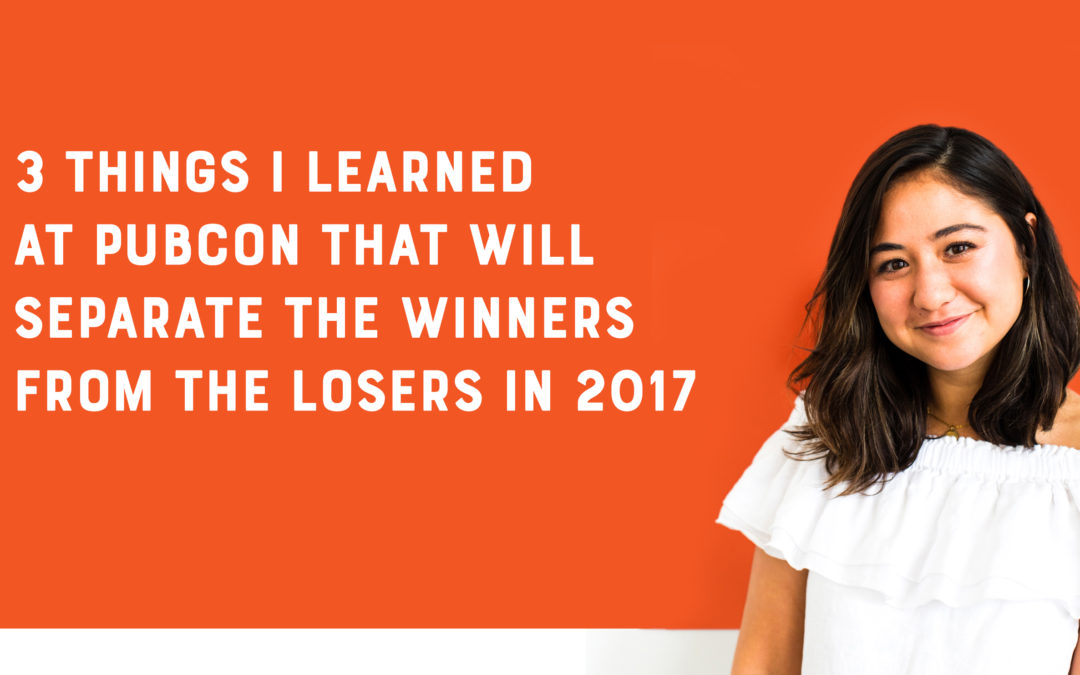
Recently I was given the amazing opportunity to attend Pubcon in Las Vegas. At Pubcon, I was overwhelmed with knowledge, tricks and industry advances that I wouldn’t have learned anywhere else. Most importantly, I was given the tools to succeed in this upcoming year.
Here you’ll find the three things I learned at Pubcon that I believe will separate the winners from the losers in the next year:
1. Capitalize on already-existing customers
Right now, most marketers think of the user’s journey in a traditional sense: awareness, consideration and conversion. While this is still true, marketers are forgoing huge wins by forgetting what happens AFTER the conversion.
We’ve been told the same thing since our marketing classes in business school: it costs WAY more to acquire a new customer than to keep an existing one (500x as much according to Samantha Noble).
So why aren’t we creating paid campaigns around retention?
Well, we are now.
As marketers, we need to start thinking of life past the traditional conversion funnel. After customers buy our products, we need to make them loyal customers. Once they are loyal customers, we need to make them evangelists.
Now our funnel looks like this:

So how do we turn customers into loyal, advocating customers?
By treating them differently.
To obtain a loyal costumer, you have to incentivize them to stay.
One of my favorite new tricks (thanks to Samantha Noble) is combining either a customer match or Re-marketing List For Search Ads (RLSA) with competitor bidding. This way any time a customer searches for a competitor, your ad is front and center, with an added incentive (loyal customers get 10% off).
Once your customer becomes and stays loyal, they can become evangelists.
One of the easiest ways to urge evangelism is through re-marketing ads (on search and social) that encourage reviews. You can then feature these reviews on your landing pages for those upper-funnel users.
Continuing the journey past conversion will massively transform your paid search advertising (and increase your ROI).
2. Optimize for voice search and micro-moments
With the introduction of personal assistants (Siri, Cortana, Alexa), advertising is transforming into a voice search world.
In fact, Comscore estimates that 50% of searches will come from voice in 2020. Voice search is making micro-moments even more important than they were before; and if you’re not optimized for voice, you’re missing out.
So how can you get ready for the voice revolution?
Schema, schema everywhere.
I know. The last thing any SEO wants to hear. But it works.
We’ve said it before, search engines already know what your content IS, schema tells search engines what your content MEANS. By putting your contact information, reviews, articles and events in the search engine’s language, you’re making it easier for them to read.
If content is easier to read, a search engine is more likely to serve it.
Optimize for more question phrases.
You want to capture your users at the “learn something” or “do something” phase. While this user isn’t necessarily going to convert, they’re going to be a lot more likely to choose you in the purchase phase down the line.
Think of commonly asked questions at your company and in your industry, and optimize around them.
Pro Tip: answerthepublic.com is a great resource for brainstorming questions. You’ll results like this:

Rethink intent and actions.
With voice search, we’re actually given a lot more data. Users are speaking naturally to their assistants, with queries like,
“When is the best time to visit New Orleans?”
This is a huge help to us.
Now we can silo our users into categories based on their intent a lot more accurately. In the above situation, the user is interested, though not likely to come stay at a hotel any time soon.
When we see a search like this,
“What is the cheapest hotel in the French Quarter?”
We can recognize higher intent. By dividing searchers into groups by intent, we can serve them more helpful information.
Additionally, voice searchers are 3x more likely to be served a local search. This is a huge opportunity. We need to provide more useful, local and on-the-go information to our users.
For instance, when creating site-links for voice searchers, think about what matters to them now. (I.e., contacting you, getting driving directions, etc.)
Finding ways to appeal to voice searchers is only going to become more and more necessary in the next few years.
3. SEO is paid search is paid social is social. And it’s all human.
As marketers, it’s so easy for us to divide and conquer our service lines, use “best practices” for each one, and call it a day. But realistically, “best practices” don’t exist in a world where your service lines don’t coexist.
In 2017, you need a holistic strategy and you need great content that makes sense to the user. After that, your advertising should fall right into place.
For instance, you create a great article. This article has dual purposes. First, creating fresh, thorough content is great for your SEO. But it’s also a perfect way to reach your audience in Facebook.
So you post the article to Facebook, throw some money behind it, and start community managing it.
Why? Because social (human!) interaction increases conversions. That’s why we take community managing so seriously at FSC.
Next, you create an audience from the people who visited your site through Facebook, and advertise to them through RLSA in paid search. That means that once they actively go searching for you and your services, you’re at the top of results.
That’s holistic, human marketing. That’s what you need to be doing in 2017.
If you want to learn more about the future of marketing, contact us today.

